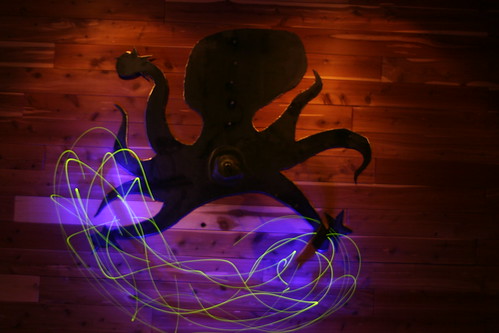Principal Investigator
Jeffrey C. ErlichPostdoctoral Fellows
Bo ZhangSylvain Dubroqua
Staff
Cequn WangYidi Chen
Students
Martin Koo (U of Toronto)Michael Lukiman (NYU Shanghai)
Collaborators
Steven LehrerZheng Zhang
Melanie Wilke
 Jeffrey C. Erlich, Ph.D.
Jeffrey C. Erlich, Ph.D. at nyu dot edu
How is chaotic neural activity, driven by internal dynamics and external sensory input, resolved into coherent behavior?
Animals have many competing goals and drives as well as a barrage of sensory input to process. If our attention and actions are as frenetic as the world around us (as may be the case in attention deficit disorder) we will have difficulty accomplishing our goals. How does the brain deal with all of this competing input? How do brain structures deal with ambiguous or conflicting sensory information? And how do different brain structures communicate, influence and compete with each other so that the result of this competition is coherent thought and action? These questions cover a range of topics: attention, decision-making, cognitive control, planning, working memory, and others.

I have performed muscimol inactivations of the frontal cortex, AgM in particular, and the posterior parietal cortex (PPC) of rats performing this task. To our knowledge, these are the first frontal and parietal cortex inactivations in animals performing an accumulation of evidence task. Our results, consistent with lesion data, show that unilateral inactivation of frontal cortex result in profound contralateral impairment. That is, rats were significantly more likely to make a response ipsilateral to the infusion site. Surprisingly, inactivations of the parietal cortex had weak and inconsistent effects on behavior. It was only when the AgM was bilaterally inactivated that unilateral inactivation of the PPC resulted in a contralateral impairment. This suggests that for this integration of information task the PPC plays a secondary role to the AgM. This is consistent with recent work from primates showing that PPC inactivations have little effect on instructed choice (Wilke, Kagan & Andersen, 2012). This work is currently being prepared for resubmission.

After the success of the classics in 2010, I wanted a new challenge. Aluminum is a great metal in the machine shop. It is lightweight and relatively soft. However, with hand controlled mills and lathes anything shape other than a bar or cylinder was pretty tricky. So I signed up for a metalworking class at the School of Visual Arts (SVA) in New York to learn how to weld and shape steel. Unfortunately, there was no furnace at the studio at SVA so we were limited to cutting, with saws, and my favorite, the plasma cutter. A plasma cutter lets you cut through a sheet of steel like a hot knife through butter. Although the studio had a computer controlled plasma cutter, I did all my cutting by hand. Using a MIG welder and the plasma cutter I made the  octostar pendulum as a gift to friends in Brooklyn.
octostar pendulum as a gift to friends in Brooklyn.
Kopec, C.D., Erlich, J.C., Brunton, B.W., Deisseroth K, and Brody C.D. (2015) Cortical and Subcortical Contributions to Short-Term Memory for Orienting Movements. Neuron, doi:10.1016/j.neuron.2015.08.033 link
Duan C.A., Erlich J.C. and Brody C.D. (2015) Requirement of Prefrontal and Midbrain Regions for Rapid Executive Control of Behavior in the Rat. Neuron, doi:10.1016/j.neuron.2015.05.042 link
Erlich J.C., Brunton B.W., Duan C.A., Hanks T.D. and Brody C.D. (2015) Distinct behavioral effects of prefrontal and parietal cortex inactivations on an accumulation of evidence task in the rat. eLife, 4:e05457. link
Hanks, T.D., Kopec, C.D., Brunton, B.W., Duan, C.A., Erlich, J. C., and Brody, C. D. (2015) Differential roles in decision-making for accumulation-correlated neurons in parietal and prefrontal cortex. Nature, 520: 220-223. link
Erlich, J. C., and Brody, C. D. (2014). What to do and how. Nature, 503: 45-47. link
Erlich, J. C., Bush, D. E. A., and Ledoux, J. E. (2012). The role of the lateral amygdala in the retrieval and maintenance of fear-memories formed by repeated probabilistic reinforcement. Front Behav Neurosci, 6: 16. link
Erlich, J. C., Bialek, M., and Brody, C. D. (2011). A cortical substrate for memory-guided orienting in the rat. Neuron, 72: 330-343. link
Pai, S., Erlich, J. C., Kopec, C., and Brody, C. D. (2011). Minimal impairment in a rat model of duration discrimination following excitotoxic lesions of primary auditory and prefrontal cortices. Front Syst Neurosci, 5: 74. link
Ross, B. M., Moszczynska, A., Erlich, J., and Kish, S. J. (1998a). Low activity of key phospholipid catabolic and anabolic enzymes in human substantia nigra: possible implications for Parkinson's disease. Neuroscience, 83: 791-798. pdf
Ross, B. M., Moszczynska, A., Erlich, J., and Kish, S. J. (1998b). Phospholipid-metabolizing enzymes in Alzheimer's disease: increased lysophospholipid acyltransferase activity and decreased phospholipase A2 activity. J Neurochem, 70: 786-793. pdf
Ross, B. M., Hudson, C., Erlich, J., Warsh, J. J., and Kish, S. J. (1997). Increased phospholipid breakdown in schizophrenia. Evidence for the involvement of a calcium-independent phospholipase A2. Arch Gen Psychiatry, 54: 487-494. pdf
Jeffrey C. Erlich (1997) The Recovered Memory Debate. pdf

During my graduate work I became very frustrated with the cost and complication of moveable microdrives. When I arrived in Princeton, I researched a design for a cheap and easy to build design. I found a design based on a bic pen. I heavily modified the design, and after several iterations and feedback from lab members, we have a very light, very cheap moveable microdrive that has been used to successfully record from many thousands of neurons in the Brody lab, including individual animals with hundreds of single units over the course of months. The details of the design and the surgical techniques that result in months of viable recording are being written up as a methods paper.
MATLAB is the programming environment of choice in the Brody Lab (and really neuroscience). I have written thousands of lines of MATLAB code and it is certainly the programming language that I am currently most fluent in. MATLAB has obvious benefits. As an interpreted language where a matrix is a primitive data type, development for analysis of data is extremely fast. There are thousands of built in functions and features that allow the quick visualization of data. It is fairly easy to read and debug. However, there are lots of things not to like about MATLAB. First, it is expensive and proprietary. Many people in the scientific community prefer the FOSS R or Python with SciPy, NumPy and MatplotLib. I recently became more acquainted with R and knitR, specifically to use the lme4 package for generalized linear mixed models. I have had a little bit of exposure to Python as well, but I would not say that I am fluent in either language.
BASH shell scripts using unix commands such as sed, awk, find, and grep are my goto for file manipulation and computer administration. My favorite thing about MacOS is that underneath all the gloss is a very Unix like OS which can be accessed through the terminal.
During my year at Nevo I became aquainted with relational databases (Oracle, specifically). When I returned to academia, i began to use MySQL to store, organize and analyze my data. Additionally, I wrote a message passing system using MATLAB and MySQL that allowed me to run analysis jobs on any machine that could run MATLAB, essentially turning the NYU neuroscience network into a computing grid. This allowed me to run statistical analyses in hours instead of weeks.
When I joined the Brody lab, MySQL was an obvious choice for helping to administer the high-throughput behavioral training facility. I also refined the message passing system into the Brody Computing Grid, so that the computers that are used for training rats during the day can be used for analysis and simulation at night. Best of all MySQL is free and open source (FOSS) software. It was acquired by Oracle in 2009 which sparked the fork of MySQL into MariaDB which is a binary equivalent of MySQL but is completely GPL and not affiliated with Oracle.
I'm very interested in non-relational databases such as SciDB which are designed for large continuous data sets, such as astronomical data. This kind of database would be appropriate for storage and analysis of continuous electrophysiological data or video. Unfortunately, I have not yet had the time to install it and try it out. If you have experience with SciDB and neuroscience get in touch!.
To apply for any position include a letter explaining your interest in the lab and in the position, your C.V. and 2-4 letters of reference to apply at erlichlab dot org